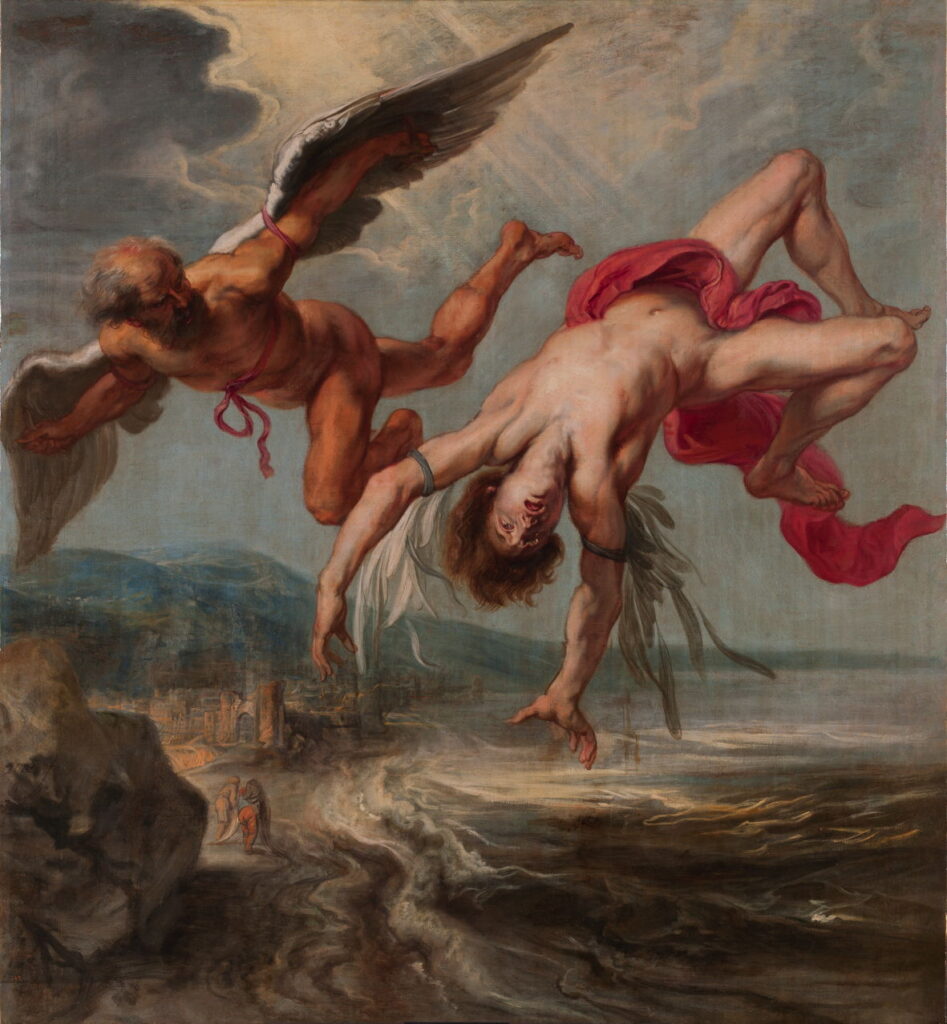Changing Paintings: 37 The fall of Icarus

The architect and artificer Daedalus had been introduced by Ovid in his account of the death of the Minotaur, and the next myth in Metamorphoses tells of the tragic end to Daedalus’ stay on the island of Crete, where he and his son Icarus had effectively been imprisoned since the construction of the labyrinth that had confined the minotaur. Much as Daedalus yearned to leave the island and King Minos, there was no hope of him departing by sea, so he decided to take to the air.
Daedalus built two sets of wings made from feathers held together by beeswax. Once they were completed, he tested his by hovering in the air. He then cautioned his son to fly a middle course: neither so low that the sea would wet the feathers and make them heavy, nor so high that the heat of the sun would damage them. He also told Icarus to follow his lead, and not to try navigating by the stars.
Daedalus fitted his son with his wings, and gave him further advice about how to fly with them. He shed tears as he did that, and his hands trembled. Once they were both ready, Daedalus kissed his son, and flew off in the lead just like a bird with its fledgeling chick in tow.
Charles Le Brun (1619–1690), Daedalus and Icarus (1645-46), oil on canvas, 190 x 124 cm, Hermitage Museum Государственный Эрмитаж, Saint Petersburg, Russia. Wikimedia Commons.
Towards the end of his career in Rome in 1645-46, the great French painter Charles Le Brun painted Daedalus and Icarus. This shows the master artificer fastening wings made of feathers and wax on his son’s back, prior to their escape from Crete.
Andrea Sacchi (1599–1661), Daedalus and Icarus (c 1645), oil, 147 x 117 cm, Musei di Strada Nuova, Genova, Italy. Wikimedia Commons.
Andrea Sacchi’s Daedalus and Icarus (c 1645) shows Daedalus at the left, fitting Icarus’ wings, prior to the boy’s flight. Icarus has his right arm raised to allow the fitting, and looks intently at his new wings. Daedalus is concentrating on adjusting the thin ribbons passing over his son’s shoulders, and may be explaining to him the importance of flying at the right altitude.
Anthony van Dyck (1599–1641), Daedalus and Icarus (1615-25), oil on canvas, 115.3 x 86.4 cm, Art Gallery of Ontario, Toronto, Canada. Wikimedia Commons.
Anthony van Dyck’s Daedalus and Icarus (1615-25) shows Daedalus giving his son the vital pre-flight briefing. From the father’s gestures, he is here explaining the importance of keeping the right altitude.
Frederic, Lord Leighton (1830–1896), Icarus and Daedalus (c 1869), oil on canvas, 138.2 × 106.5 cm, Private collection. Wikimedia Commons.
Frederic, Lord Leighton’s Icarus and Daedalus (c 1869), shows the pair on the roof of a tower overlooking the coast. Daedalus is fitting his son’s wings, and looks up at Icarus. The boy holds his right arm up, partly to allow his father to fit the wings, and possibly in a gesture of strength and defiance, as the two will shortly be escaping from Crete. Icarus looks to the right, presumably towards their mainland destination, and Daedalus is wearing a curious scalp-hugging cap intended for flight.
Charles Paul Landon (1760–1826), Icarus and Daedalus (1799), oil on canvas, 54 × 43.5 cm, Musée des Beaux-Arts et de la Dentelle d’Alençon, Alençon, France. Wikimedia Commons.
Charles Paul Landon’s (1760–1826) Icarus and Daedalus (1799) shows the moment that Icarus launches into flight from the top of the tower, his arms held out and treading air with his legs during this first flight. Daedalus stands behind, his arms still held horizontally forward from launching his son.
The pair flew over a fisherman holding his rod, a shepherd leaning on his crook, and a ploughman with his plough, amazing them with the sight. They flew past Delos and Paros, and approached further islands, but Icarus started to enjoy the thrill of flying too much, and soared too high. As he neared the sun, the wax securing the feathers in his wings softened, and his wings fell apart.
As Icarus fell from the sky, he called to his father, before entering the water in what’s now known in his memory as the Icarian Sea, between the Cyclades and the coast of modern Turkey. All Daedalus could see were the feathers, remnants of wings, on the surface of the water.
Peter Paul Rubens (1577–1640), The Fall of Icarus (1636), oil on panel, 27 x 27 cm, Royal Museums of Fine Arts of Belgium, Brussels. Wikimedia Commons.
Rubens’ initial oil sketch of The Fall of Icarus (1636) above, was presumably turned into a finished painting by his apprentice Jacob Peter Gowy, below. Icarus, his wings in tatters and holding his arms up as if trying to flap them, plunges past Daedalus. The boy’s mouth and eyes are wide open in shock and fear, and his body tumbles as it falls. Daedalus is still flying, though, his wings intact and fully functional; he looks towards the falling body of his son in alarm. They are high above a bay containing people with a fortified town at the edge of the sea.
Jacob Peter Gowy (c 1615-1661), The Fall of Icarus (1635-7), oil on canvas, 195 x 180 cm, Museo del Prado, Madrid. Wikimedia Commons.
Merry-Joseph Blondel (1781-1853), The Sun or the Fall of Icarus (1819), mural, 271 x 210 cm, Denon, first floor, Rotonde d’Apollon, Musée du Louvre, Paris. By Jastrow (2008), via Wikimedia Commons.
Merry-Joseph Blondel’s spectacular painted ceiling showing The Sun or the Fall of Icarus (1819) combines a similar view of Daedalus flying onward, and Icarus in free fall, with Apollo’s sun chariot being driven across the heavens.
Joos de Momper (II) (1564–1635), Landscape with the Fall of Icarus (c 1565), oil on panel, 154 x 173 cm, Nationalmuseum, Stockholm, Sweden. Wikimedia Commons.
Joos de Momper’s Landscape with the Fall of Icarus (c 1565), above, show Icarus’ descent within a much bigger landscape, including some of Ovid’s finer details:
an angler catching a fish with a rod and line,
a shepherd leaning on a crook,
a ploughman resting on the handles of his plough.
To aid the viewer, de Momper has painted their clothing scarlet.
De Momper may also have made the copy, below, of Pieter Brueghel the Elder’s famous Landscape with the Fall of Icarus. Here, Brueghel makes the viewer work harder to see the crucial elements of the story: all there is to be seen of Icarus are his flailing legs and some feathers, by the stern of the ship at the right. Daedalus isn’t visible at all, but the shepherd leaning on his crook is looking up at him, up to the left. As in de Momper’s own version, Brueghel also shows the ploughman and the angler.
Pieter Brueghel the Elder (1526/1530–1569), Landscape with the Fall of Icarus (copy of original from c 1558), oil on canvas mounted on wood, 73.5 × 112 cm, Royal Museums of Fine Arts of Belgium, Brussels. Wikimedia Commons.
Vlaho Bukovac (Biagio Faggioni) (1855–1922) The Fall of Icarus (panel of diptych) (1898), oil, dimensions not known, National Museum of Serbia, Beograd, Serbia. Wikimedia Commons.
Vlaho Bukovac (Biagio Faggioni) (1855–1922) painted two different versions of Icarus reaching earth: in The Fall of Icarus (1898), one panel of a diptych about this story, he shows Icarus on the seabed, as he drowns, the remains of his wings still visible.
Vlaho Bukovac (Biagio Faggioni) (1855–1922) Icarus on the Rocks (1897), oil on canvas, dimensions not known, Moderna Galerija, Zagreb, Croatia. Wikimedia Commons.
His earlier Icarus on the Rocks (1897) departs from Ovid’s account and has Icarus crash onto rocks; his posture is similar in the two paintings.
Herbert James Draper (1863–1920), Lament for Icarus (1898), oil on canvas, 182.9 x 155.6 cm, The Tate Gallery, London. Wikimedia Commons.
Finally, Herbert Draper’s (1863–1920) Lament for Icarus (1898) shows an apocryphal and more romantic view, in which three nymphs have recovered the apparently dry body of Icarus, and he is laid out on a rock while they lament his fate to the accompaniment of a lyre. Perhaps influenced by contemporary thought about human flight, Draper gives Icarus huge wings, and those are shown intact, rather than disintegrated from their exposure to the sun’s heat.
Daedalus was full of remorse, and buried his son’s body on the nearby island. As he was digging his son’s grave, a solitary partridge watched him from a nearby oak tree. The partridge had originally been Daedalus’ nephew, who had been brought to him as an apprentice. As the nephew’s skills and ingenuity grew, Daedalus became envious of him, seeking to kill him and pretend it had been an accident. When Daedalus threw him from the roof of her temple on the Acropolis, Pallas Athena saved the apprentice by transforming him into a partridge in mid-air. The bird still remembers being saved from its fall, and to this day won’t fly far above the ground.


